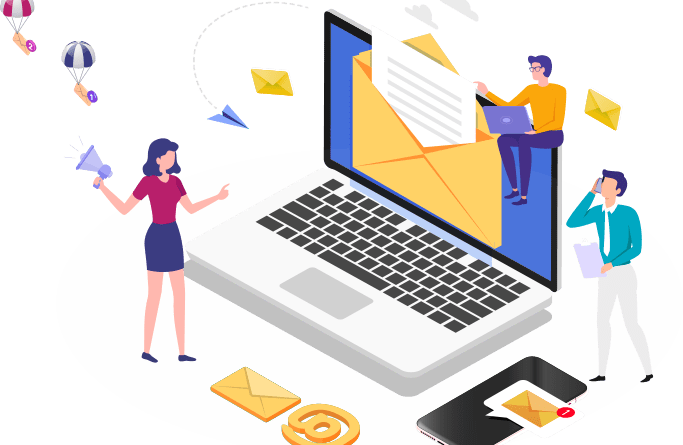Avoid These Common Mistakes in Educational Email Marketing
1. Neglecting Segmentation
Why Segmentation Matters
One of the most frequent mistakes in educational email marketing is failing to segment your audience. Sending the same message to everyone on your list can lead to irrelevant content for many recipients, reducing engagement rates and increasing unsubscribes.
Effective Segmentation Strategies
- Student vs. Parent vs. Alumni: Tailor content based on the recipient’s role. For example, provide current students with academic updates and parents with school events.
- Grade Levels and Programs: Segment by academic levels or programs to deliver more relevant information, such as program-specific updates or course details.
2. Overlooking Personalization
The Power of Personalization
Personalized emails have higher open and click-through rates compared to generic ones. When emails address recipients by name and include content relevant to their interests or needs, they resonate more.
Personalization Tips
- Dynamic Content: Use dynamic content blocks to customize sections of your emails based on recipient data.
- Behavior-Based Triggers: Implement triggers for actions like course sign-ups or event registrations to send targeted follow-ups.
3. Ignoring Mobile Optimization
The Mobile Imperative
With more users accessing emails on mobile devices, failing to optimize for mobile can significantly impact user experience and engagement. Emails that are not mobile-friendly can result in poor readability and increased bounce rates.
Mobile Optimization Best Practices
- Responsive Design: Ensure your emails adapt to different screen sizes.
- Concise Copy: Use short, engaging text that’s easy to read on small screens.
- Clickable Buttons: Make sure buttons and links are easy to click on mobile devices.
4. Lack of Clear Call-to-Actions (CTAs)
The Importance of CTAs
A well-defined CTA guides recipients on what action to take next. Emails without clear CTAs can leave recipients confused about how to engage further.
Crafting Effective CTAs
- Be Specific: Use clear, action-oriented language like “Register Now” or “Download Your Guide.”
- Placement: Position CTAs prominently and ensure they stand out from the rest of the content.
5. Failing to Test and Analyze
The Need for Testing
Many educational institutions send emails without testing them first. This can lead to errors in formatting, broken links, or other issues that can undermine your campaign’s effectiveness.
Testing and Analysis Tips
- A/B Testing: Experiment with different subject lines, content formats, and sending times to determine what works best.
- Performance Metrics: Analyze open rates, click-through rates, and conversion rates to gauge your campaign’s success and make data-driven improvements.
6. Sending Too Many or Too Few Emails
Finding the Right Balance
Striking the right balance between too many and too few emails is crucial. Overloading recipients with emails can lead to unsubscribes, while infrequent communication can result in decreased engagement.
Optimal Email Frequency
- Regular Updates: Develop a schedule that keeps your audience informed without overwhelming them. Monthly or bi-monthly newsletters can be effective.
- Event-Driven Emails: Send additional emails for specific events or important announcements as needed.
7. Ignoring Compliance and Privacy Laws
Compliance Essentials
Educational institutions must adhere to email marketing regulations, such as GDPR or CAN-SPAM, to avoid legal issues and maintain trust.
Compliance Tips
- Opt-In Consent: Ensure recipients have opted in to receive emails.
- Clear Unsubscribe Options: Include an easy-to-find unsubscribe link in every email.
- Privacy Policies: Clearly communicate how recipient data will be used and protected.
8. Neglecting Content Quality
Content is King
High-quality content is essential for effective email marketing. Poorly written or irrelevant content can disengage recipients and damage your reputation.
Creating Engaging Content
- Relevance: Focus on topics that are important to your audience, such as upcoming events, important deadlines, or academic achievements.
- Visual Appeal: Use images, infographics, and well-designed templates to make your emails visually appealing.
9. Not Utilizing Automation
The Benefits of Automation
Automation can streamline your email marketing efforts, making it easier to send timely and relevant messages without manual intervention.
Automation Strategies
- Welcome Series: Set up an automated series for new subscribers, including a welcome message and introductory content.
- Reminder Emails: Automate reminders for deadlines, events, or important actions to keep your audience informed and engaged.
10. Neglecting Follow-Up
The Power of Follow-Up
Failing to follow up after initial contact can result in missed opportunities for engagement and conversion.
Effective Follow-Up Tactics
- Reminder Emails: Send follow-ups to remind recipients of upcoming deadlines or events.
- Engagement Sequences: Develop sequences that nurture leads through the enrollment or application process.
Conclusion
Avoiding these common mistakes in educational email marketing can significantly enhance your campaigns’ effectiveness, leading to better engagement and improved outcomes. By focusing on segmentation, personalization, mobile optimization, clear CTAs, testing, compliance, content quality, automation, and follow-up, you can create email campaigns that truly resonate with your audience and drive meaningful results. Implement these strategies to elevate your educational email marketing and achieve greater success.
About Us:
SpaceEdge Technology appears to be a term that might refer to a company, concept, or technology related to space exploration or utilization. However, without further context, it’s challenging to provide specific information.




